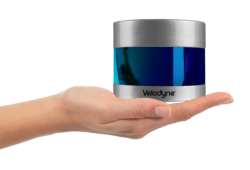Velodyne Ultra Puck review
Posted on August 20, 2020 in Blog, News
by Gert Riemersma, CTO Mapix technologies Ltd
The Ultra Puck, otherwise known as the VLP-32C, is the latest longer range 3D LiDAR sensor within Velodyne’s portfolio. It boasts an impressive specification which has become more attractive due to a recent considerable price reduction (as a result of the removal of the Puck 32MR (VLP-32MR) from the product range).
At Mapix technologies Ltd, an established Velodyne distributor working with LiDAR since 2008, we always test and review each new product. Understanding each product’s capabilities and limitations enables us to recommend the best sensor for each customer application. In this review we have assessed the Ultra Puck and compared it to other sensors in the Velodyne range.
1. Assessment of the Ultra Puck
This long range LiDAR sensor provides exceptional resolution with 32 lasers, a narrow beam separation, a broad field of view and up to 200 metre range. The result is a sensor which produces a point cloud with minimal noise, best in class accuracy and calibrated intensity, all at a very competitive price.
Independent testing by Mapix technologies
Mapix technologies have evaluated the Ultra Puck at our own test location in Leith, Edinburgh, Scotland. Over the years we have tested numerous LiDAR scanners, including the complete Velodyne product range. Tests are all performed at the exact same spot so that we can make a direct comparison of the performance of each scanner. The test location was specifically chosen as it offers many of the objects that end users may wish to detect, map or analyse. Located in an urban setting, the test location has a busy road with pedestrians and a regular flow of traffic including public buses. The scanners are set up on a bridge spanning a river and it is overlooked by a variety of different buildings, this feature-rich test location enables us to analyse the capability of each sensor.
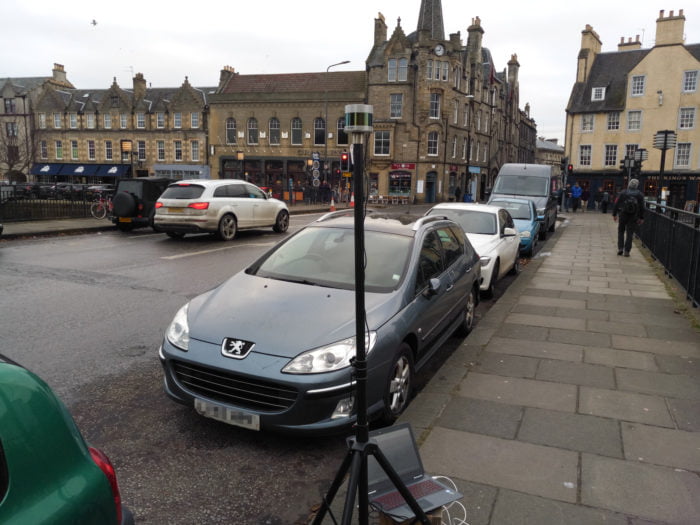
The Mapix technologies test location in Leith, Edinburgh, Scotland
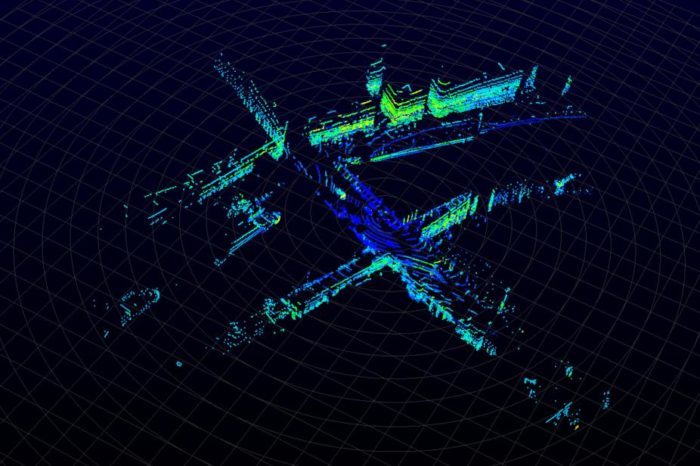
Point cloud view of the Mapix technologies test location
To enable a direct comparison between different scanners we undertake a series of scans which includes a variety of different objects visible at different ranges, such as pedestrians at 5m, 20m and 30m, double decker buses at 9m and 30m, and cars at 10m and 20m range. From these scans, we determine the number of scan lines and hits on each targeted object. We analyse the buildings visible in the scans as this provides a useful indication of the scanner’s capability with respect to range and reflectivity. There are several distinct buildings made of different materials and coatings, including a white rendered building overlooking the river which allows us to give a good estimate of the maximum range capability of the scanner in an urban setting.
Results: Range confirmed as 200m
The range that we achieved with the Ultra Puck was 200m, exactly as specified by Velodyne. At the maximum range of 200m the Ultra Puck still provides a reasonable vertical offset between laser beams, which at the centre of the Field of View equates to a beam separation of 1.15m, which is sufficient to detect a mid sized object.
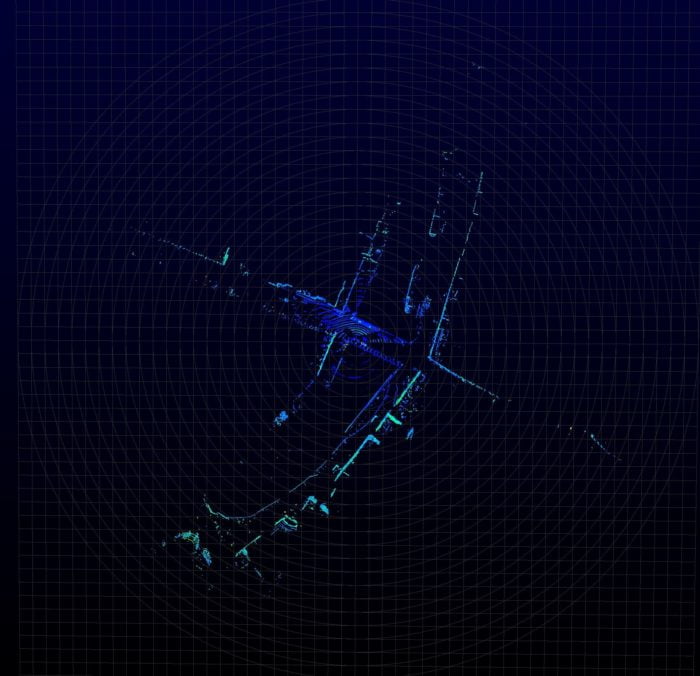
Ultra Puck at a range of 200m
Summary: High quality long-range LiDAR sensor
The Ultra Puck stands out from the growing number of available scanners from Velodyne and competitors. It is a high resolution 360 degree scanner which provides a rich and detailed point cloud at ranges up to 200m. The 32 lasers provide good coverage over the 40 degree vertical Field of View, the lasers at the centre are spaced at 0.33 degrees, ensuring that any object that is imaged is able to be detected and classified. The Ultra Puck has interference mitigation features built in to ensure it is ready for a time in the near future when multiple LiDAR equipped autonomous vehicles will be on the road at the same time.
The Ultra Puck scanner is built with automotive grade components, has a small form factor and is lightweight at 925 grammes. It is Class 1 eye safe, and is CE Certified. This scanner has been extensively field tested and is proving popular in the autonomous car and shuttle market.
Applications for the Velodyne Ultra Puck
The Ultra Puck is suitable for applications which need robust and high resolution 3D perception, precise real-time localisation and object detection in the long range. The sensor has advanced features for minimising false positives, and is power efficient.
- Automotive: exceptional for use in urban areas where the volume of traffic and the built environment restrict the range at which objects can be perceived; can be used to detect objects such as crosswalks, curbs and obstacles
- Industrial robotics: such as obstacle avoidance in warehouse aisles for safe and efficient navigation
- Marine: manoeuvring of vessels at close range in ports
- Security: particularly where the alarm zone is in a confined space; high fidelity and resolution enabling easy fusion with CCTV imagery.
2. Sensor comparison across the Velodyne product range
a. Ultra Puck v Puck (VLP-16)
The Ultra Puck is a much higher performance LiDAR scanner than the Puck, which we consider the entry level scanner in the Velodyne product range. With double the number of lasers, the Ultra Puck generates double the number of data points than the Puck. In addition, the narrower spacing between beams provides much higher resolution with the Ultra Puck, in particular at the centre of the Field of View. The range of the Ultra Puck is good to 200m, whilst the Puck has a measurement range of up to 100m, the usable range very much depends on the reflectivity of the object being scanned.
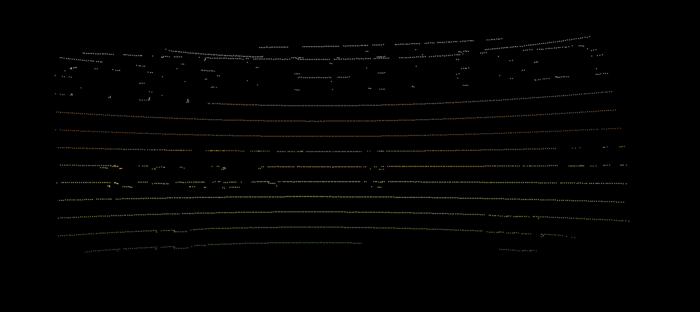
Returns received scanning a double-decker bus at 9 metres using a Puck
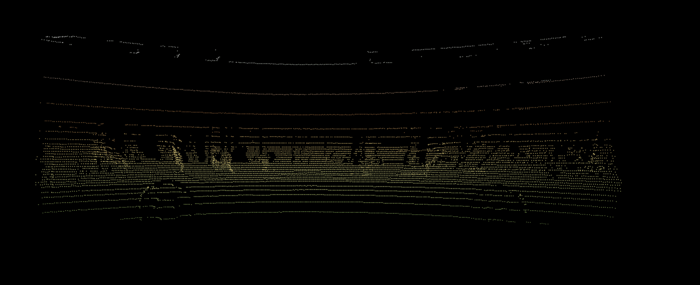
Returns received scanning a double-decker bus using an Ultra Puck
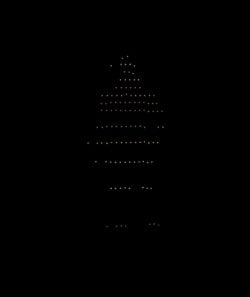
Ultra Puck person scanned at 10 metres
Leveraging your Puck before upgrading to an Ultra Puck
The Puck allows a user to experiment and become familiar with the capabilities of powerful 360 degree LiDAR scanners at a low price point.
For those on a tight budget who are unable to afford an Ultra Puck, there is a way to leverage extra performance from your Puck before upgrading, this includes for example: reducing the rotational speed of the scanner to 5Hz, thus improving the horizontal resolution; enabling dual return; aggregating several scans to ensure that small objects falling in between the laser beams are still detected. This technique works in low speed dynamic environments, where the displacement between successive scans is small. It should be noted that this technique will reduce the effective update rate of the scanner. At higher speeds the ‘noise’ and uncertainty created by aggregating scans becomes impractical and this is the time to consider an upgrade to the Ultra Puck.
b. Key comparisions across scanners in the Velodyne product range
|
Puck |
Ultra Puck |
HDL-32 |
|
|
Price |
£ |
£££ |
£££ |
|
Max range |
100m |
200m |
80m |
|
Number of lasers |
16 |
32 |
32 |
|
Horizontal Field of View (FoV) |
360° |
360° |
360° |
|
Vertical Field of View |
30° |
40° |
41.33° |
|
Horizontal Resolution |
0.1°-0.4° |
0.1°-0.4° |
0.08°-0.33° |
|
Vertical Resolution |
2.0° |
0.33° |
1.33° |
|
Points per Second (Single Return Mode) |
~ 300,000 |
~ 600,000 |
~ 695,000 |
|
Points per Second (Dual Return Mode) |
~ 600,000 |
~ 1,200,000 |
~ 1,390,000 |
|
Weight |
~830 g |
~925 g |
~1.0 kg |
Download the full Velodyne Lidar Product Comparision Guide
|
Application |
Puck |
Ultra Puck |
HDL-32 |
|
Automotive |
Yes |
||
|
Low speed shuttles in confined areas |
Yes |
Yes |
|
|
Industrial robots |
Yes |
||
|
Marine |
Yes |
Yes |
|
|
Security |
Yes |
Yes |
|
|
Survey & Mapping (Terrestrial & UAV) |
Yes |
||
|
UAV collision avoidance |
Yes |
Yes |
c. Recommended applications across scanners in the Velodyne product range
Survey & Mapping: We continue to recommend the Velodyne HDL-32. This scanner has a much higher range accuracy than the Puck or Ultra Puck, which is by far the most important factor in this application. The low noise of the scanner makes it easier to post-process the data and enables small objects and terrain undulations to be easily detected.
UAV collision avoidance: When using LiDAR for mid air collision avoidance, then the Ultra Puck is good when you have a high closing speed and as such a long reaction and avoidance time is necessary. So the Puck is good when the closing speed is much lower. The higher the closing speed the longer the detection range required. Another factor to consider is the size of the object to detect and avoid, with the Ultra Puck providing the ability to detect smaller objects at longer ranges.
d. Comparison summary
In conclusion the Velodyne Ultra Puck is a 32 channel, long range LiDAR scanner, with a range of 200m, and has good returns at this range. It is positioned in between the low cost Puck and the more expensive, 128 Channel 245m range Alpha Prime. If you are looking for a scanner for automotive, industrial robotics, marine or security applications and you only need a range of 200 metres, then the Velodyne Ultra Puck (VLP-32) is priced very competitively and worth a closer look.
Please contact us to see how LiDAR can make a difference to your project.
Contact us
About the author
Gert Riemersma is founder and CTO of Mapix technologies and has been working with LiDAR since 2008. Based in Edinburgh, Scotland Mapix technologies specialises in LiDAR technology and integration. Mapix technologies are the official distributors for Velodyne in UK, Ireland, Belgium, Luxembourg and the Netherlands.

